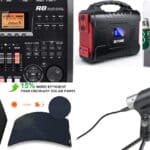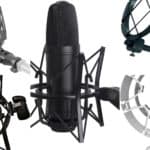Build An Excellent Podcasting Haven With The Best Acoustic Panels

Last updated on November 12th, 2023
*Editors Note* As a musician and having spent the better part of my 20s recording records, I know first hand how important acoustic panels are to deadening a space and ensuring the best, bell tone, crystal clear, audio makes it to “tape.” If you aren’t on the move, investing in some quality deadening material, like acoustic panels for walls and ceilings, may make the difference in someone listening past the first thirty seconds of your show.
Designing a podcast studio is crucial to creating high-quality audio content. A well-designed studio ensures that sound quality is consistent, and unwanted noise is minimized. In this article, we will discuss the importance of acoustic treatment and how to use acoustic panels to improve the sound quality in a podcast studio. We will explore the different types of studio acoustic panels available in the market, their placement and positioning, and how to calculate the ideal amount of panels required for a given space.
Additionally, we will discuss other essential elements of podcast studio design, including room size, equipment, and furniture. Whether you’re a beginner or a seasoned podcaster, this article will provide you with practical tips and guidelines to help you design a podcast studio that meets your needs and budget.
Acoustic Panels: The Top Priority for Achieving Sound Quality

The beauty of podcasting in 2023 is that the barriers to entry are very low.
All you need is a computer, internet connection, and a voice to send your content into cyberspace.
While this is exciting, it is important to remember that the democratization of content consumption is just as real. Listeners have unprecedented choice in what they download. Therefore, if your podcast sounds elementary, it will not be taken seriously by your target audience and relegated to the dark recesses of the internet.
Aside from creating engaging episodes, guaranteeing professional-caliber sound quality is arguably the most important aspect of achieving podcasting success. Listeners simply won’t give grainy, distorted, or hard-to-hear podcasts the time of day.
The good news is that you don’t need to completely remodel a room of your home to achieve optimal sound quality. Modern acoustic panels adhere to walls in a profile similar to a hanging picture frame and can absorb close to 100% of sound when properly deployed. They are usually wrapped in a decorative fabric that not only improves sound quality in the studio, but also enhances the recording ambience.
What is the best insulation for acoustic panels?
Well, there are several options, all of which have their own unique benefits. Some of the most prevalent include:
- Fiberglass – this is arguably the most popular type of insulation for acoustic panels. Fiberglass panels have a very high soundproofing density, meaning that they do not require a super-thick batt to absorb sound. When properly deployed, they can provide a noise reduction coefficient (NRC) of .99, just short of the industry standard (1) for complete soundproofing.
- Mineral wool – this is another material that can provide an NRC close to 1. While it is a bit thicker than fiberglass to achieve the same results, it does have the benefit of also providing some weather insulation as well, making a good consideration for exterior recording spaces. The downside is that it is more expensive and harder to come by.
- Rigid polyester – this is a good option for studios that want very low-profile, dust, and allergen free panels. Rigid polyester is readily accessible and affordable. The downside is that its NRC is much lower–around .7–and that it offers little utility against lower frequency sounds.
- Foam – foam is the most basic type of sound insulation panel and usually has a price tag to reflect this. The benefit of choosing foam is that textured surfaces create more sound-absorbing surface area than footprint on the wall. The downside to foam is that the aesthetics are extremely limited and that it has a tendency to deflect sound, rather than absorb it.
When talking about acoustic panels, you may have flashbacks to those light-hearted Hollywood romps where aspiring garage bands tape egg cartons to every square inch of the walls to soundproof the space. (*Editor’s Note*: Guilty)
That is not the case with modern acoustic panels.
While rigid polyester and foam products may require a bit more wall coverage, fiberglass and mineral wool panels can usually achieve their optimal NRC in much less space, usually around 15-25% of wall area.
While that may sound a bit technical for the budding podcaster (you’re just trying to make your show, right?), it means that you have quite a few options and price points that you can explore.
Some of the more advanced acoustic panels for walls blend right into the interior space to the point where you can’t visually tell they are serving an acoustic function. That’s great if you’re converting some living space in your home into a dedicated podcasting studio.
Ask any real estate agent about the resale value of building material that blends into the background versus something that sticks out like a sore thumb from the 90s. And since everyone should have a podcast, I think we’re going to see more of these retrofitted, dedicated spaces as content creation becomes one of the last bastions of the workforce.
Create a Functional Recording Layout

Although acoustic panels are the top priority for creating a high-quality podcast studio, they are far from the only consideration. It is also critical to create a set-up and workstation that promotes optimal productivity. Some ideas include:
- Include an adjustable height sit/stand computer desk to promote ergonomics and carefully organize all scripts and facilitate note-taking during recording
- Consider a futon to comfortably accommodate any studio visitors
- Replace a hinged door with a sliding pocket door to maximize square footage in the space
It is also very important to have all recording equipment on hand and well-organized for immediate access when recording episodes. This includes microphones, pop filters, and any cables/cords for connecting external recording hardware.
Go the Extra Mile When Designing Your Podcasting Haven

In an increasingly crowded podcasting scene, professional sound quality can be the difference between a monetized podcast and one that only mom listens to. This begins and ends with studio design. While choosing the right acoustic panels is the first place to start, don’t neglect the importance of creating a comfortable and productive work atmosphere as well.
For more ideas on how to optimize your dream podcast studio, head over to Discover Pods today for ideas and inspiration!













Comments
Comments are closed.